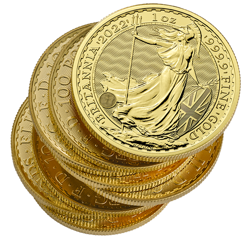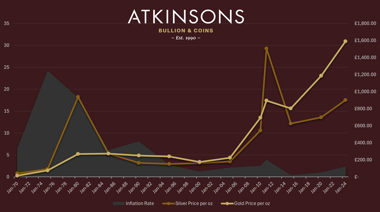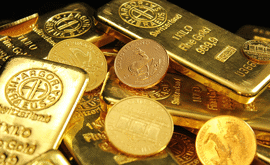How Does Inflation Affect Silver and Gold Prices?
Understanding how inflation can affect the prices of silver and gold prices is crucial for anyone involved in the precious metals market. During periods of high inflation, people often flock to gold and silver which results in driving up demand and prices. Alternatively, in times of low inflation, demand often lowers, resulting in lower prices.
This article discusses the relationship between inflation and the prices of silver and gold, examining how and why their prices react to inflationary changes, and exploring the reasons why buying gold and silver is considered to be a hedge against rising inflation.
What is inflation?
Inflation is the rate at which the price of goods and services may increase over time, which results in a decrease in the purchasing power of money. The level of inflation is measured by the Consumer Price Index (CPI), which tracks the prices of a standard basket of goods and services over time. For example, if the inflation percentage in the UK is 5%, this means that prices are, on average, 5% higher than they were a year ago, and, as a result, £100 today will buy fewer goods and services than it did last year.
To illustrate this, imagine a person spends £100 on groceries each month. With 5% inflation, the same basket of groceries that cost £100 last year would now cost £105. This means the consumer will need an extra £5 to buy the same items, or will simply purchase fewer items. Over time, even a small inflation rate can impact purchasing power, making everyday items more expensive and reducing the standard of living if the consumer’s income does not keep up with the pace of inflation.
Inflation increases the prices of everyday essential items like bread, milk, and vegetables, which has a direct impact on household budgets. The housing sector is also affected, meaning rent and mortgage payments usually increase, and transportation costs often rise due to higher fuel prices, affecting everything from personal car usage to public transport fares. Healthcare expenses also often increase, making medical care and medicines more expensive.
Wages and savings can also be affected by inflation. While wages sometimes increase to keep up with inflation, they often lag behind, resulting in a lower real income. Savings can also lose value, if the interest rates on savings accounts are lower than the inflation rate. For example, if you save £1,000 in a bank account with a 1% interest rate, but the inflation rate is 5%, the real value of your savings will decrease because the interest earned does not keep up with the rising prices.
Understanding inflation is important for financial planning as people can then make more informed decisions about their spending, saving, and investing. Governments also track inflation closely as it can often influence economic policies and interest rates.
Do silver and gold go up with inflation?
Inflation has a powerful influence over gold and silver, often pushing their prices up. Historically, precious metals have been used as safe haven assets during difficult economic times, such as rising inflation. Precious metals are a tangible commodity with a limited supply, so their value tends to hold during periods of high inflation as investors turn away from stocks, bonds, and other assets in favour of gold and silver. This pushes up demand, resulting in higher precious metals prices.
However, the relationship between inflation and the prices of gold and silver can be complex as they are also influenced by a range of different economic factors.
Gold
Gold is seen as a safe haven during times of economic uncertainty and inflation. When inflation rises, the value of fiat currencies tends to fall, making tangible assets like gold more attractive. During past periods of high inflation, such as the late 1970s and early 1980s, the price of gold surged as investors flocked to the precious metal to preserve their wealth. However, it is important to note that gold prices can also be influenced by other factors, such as geopolitical tensions, interest rates, and currency fluctuations. While gold often performs well during periods of rising inflation, there can also be other reasons behind its price movements.
Silver
Silver, like gold, is considered to be a hedge against inflation, but its behaviour when it comes to the price can differ slightly thanks to its dual role as both a precious metal and an industrial commodity. During times of high inflation, the price of silver often rises as investors look for alternatives to the falling value of fiat currency, but the industrial demand for silver, such as electronics, solar panels, and other applications, can also drive its price. However, this industrial demand can often make silver more volatile than gold, and while silver does tend to perform well during times of rising inflation, its price can also be more sensitive to changes in industrial demand and economic conditions.
Does inflation affect gold prices?
Inflation does affect gold prices. Historically, gold’s value tends to increase when inflation rises. This is because when the purchasing power of currency declines due to inflation, investors often look to gold to preserve their wealth.
Gold has a long history of being used as a store of value. During periods of high inflation, when the value of paper money decreases, and the prices of goods and services increase, gold often becomes more attractive because it retains its value better than currency.
Why gold performs well during inflation
Gold performs well during inflation for several reasons:
- Intrinsic value: Unlike paper money, gold has intrinsic value. It is a tangible asset that cannot be printed or created at will, which helps it to maintain its value over time.
- Limited supply: The supply of gold is limited. This limited supply means that gold is less sensitive to inflationary pressure compared to fiat currency that can be easily printed.
- Safe haven: During times of economic uncertainty and rising inflation, gold is seen as a safe haven and investors flock to gold to secure their wealth, increasing its demand and price.
Will the gold price go down?
While gold tends to perform well during periods of inflation, it is important to remember that its price can also be influenced by other factors such as interest rates, currency strength, geopolitical stability, and overall economic conditions. For example, if interest rates are raised in an attempt to tackle inflation, holding gold (which does not yield interest) can become less attractive to some investors, potentially lowering the price of gold. While inflation often raises gold prices, it is not the only factor that can influence the price, and it is important to look at the overall economic situation when attempting to predict any movements in the gold price.
Will silver prices go up with inflation?
Silver, like gold, is often seen as a hedge against inflation, and its prices also tend to rise when inflation increases. However, silver's behaviour can be a little more complex because it serves as both a precious metal and an industrial commodity.
Historically, silver has performed well during periods of rising inflation, although it tends to be more volatile than gold. This is partly because silver is not only valued for its use as a store of wealth but also for its wide range of industrial applications, such as electronics, solar panels, and medical devices. When inflation is high, the increased cost of production materials can often drive up the price of silver.
During the late 1970s and early 1980s, when inflation in the UK was particularly high, silver prices experienced significant increases. For example, the price of silver soared from around £1 per ounce in 1970, to reaching over £18 per ounce in 1980, driven by both inflationary pressures and strong industrial demand.
This table reflects the relationship between silver prices and inflation from 1970 to 2024:
| Year | Silver price (per oz) | Inflation rate (%) |
|---|---|---|
| Jan 1970 | 0.77 | 6.37 |
| Jan 1975 | 1.80 | 24.21 |
| Jan 1980 | 18.21 | 17.97 |
| Jan 1985 | 5.34 | 6.07 |
| Jan 1990 | 3.20 | 8.06 |
| Jan 1995 | 2.94 | 2.70 |
| Jan 2000 | 3.13 | 1.18 |
| Jan 2005 | 3.51 | 2.09 |
| Jan 2010 | 10.58 | 2.49 |
| April 2011 | 29.26 (highest ever) | 3.86 |
| Jan 2015 | 12.17 | 0.37 |
| Jan 2020 | 13.58 | 0.99 |
| Jan 2024 | 17.52 | 2.30 |
Why silver prices rise with inflation
- Tangible asset: Like gold, silver is a tangible asset with intrinsic value, making it viewed as a safe haven during times of inflation.
- Industrial demand: Silver's use in a range of industries means that higher production costs during inflationary periods can drive up its price.
- Investor demand: During periods of high inflation, many investors seek to protect their wealth by purchasing silver, increasing its demand and price.
Will the silver price go down?
Historical trends suggest that silver prices often tend to rise with inflation, but this is not always guaranteed, as there are other factors that can also impact the price of silver. Industrial demand for silver can also have a significant effect, and during times of economic downturns or technological changes, silver prices could fall. Also, the silver market is smaller and more volatile than that of gold, which can lead to larger swings in the price.
While silver prices are highly likely to rise with inflation due to its use as a hedge as well as its industrial demand, it is important to remember that these are not the only factors that can influence the price. By looking at historical trends as well as the current economic situation, we can understand any silver price movements in response to inflation.
Are gold and silver inflation-proof investments?
Gold and silver are often seen as hedges against inflation because of their intrinsic value and limited supply. However, whether they are completely effective as inflation-proof assets depends on a few different factors.
While gold and silver typically stay strong when inflation is rising, their prices can also be affected by other market influences. Gold and silver can be used as inflation hedges, but they are not completely without risks. Market volatility, geopolitical tensions, and fluctuations in the value of a currency are all things that can all result in a change in the prices of precious metals, and unlike some other assets such as stocks or property, gold and silver do not generate dividends or interest.
When considering buying gold and silver assets, we can compare them against other options such as stocks, bonds, and property. Real estate, like precious metals, is also seen as a hedge against inflation, with UK property values also typically rising with inflation. However, owning property comes with maintenance expenses, taxes, high entry barriers, and limited liquidity, making it less accessible and flexible compared to gold and silver.
Stocks and bonds can have different advantages during times of inflation. Stocks represent ownership in companies, so their value may rise as businesses raise their prices to keep up with inflation. However, bonds usually give fixed interest payments, which can lose value during inflation. Unlike gold and silver, stocks and bonds may generate income through dividends and interest, but they also come with risks and can be more volatile.
While gold and silver can offer some protection against inflation and help to diversify a portfolio, they perhaps should be part of a larger, long-term plan. Before buying gold and silver, individuals should carefully consider their financial goals, risk tolerance, budgets, and timeline.
How to invest in gold and silver
Buying gold and silver can be a way of protecting against economic pressures, especially if it seems like inflation may get worse in the future. Precious metals are often seen as safe havens during uncertain times, and holding physical gold and silver coins and bars can be particularly valuable, especially during ‘black swan’ events like the Covid-19 pandemic, which can threaten the global economy.
Owning physical assets such as gold and silver can allow you to have tangible wealth that often retains value, even when currencies or other assets lose value due to inflation or economic turmoil.
When choosing to buy physical gold and silver in the form of coins or bars, it is important to purchase from a reputable dealer. A quick online search can help you find dealers with numerous positive reviews from genuine clients as well as the best value for your money. Bullion coins issued by government mints, such as the UK Britannia, UK Sovereign, USA Eagle, or the Canadian Maple Leaf, are widely recognised assets all over the world and are often popular. Bullion bars, typically available in a wide range of weights, offer a convenient way for those looking to own larger quantities of gold and silver.
Owing physical gold and silver coins and bars can be a way to protect against economic pressures, especially during times of rising inflation or unexpected events. By choosing reputable dealers and widely recognised bullion products, as well as considering your future goals, you can ensure your investment in these precious metals is as secure and valuable as possible.
Why Join Our Mailing List?
By signing up, you'll gain access to exclusive updates, early announcements, and tailored insights into the world of bullion and precious metals.

Latest Updates On Bullion

New Releases

Special Offers

Market Analysis
Sign Up Today
This blog represents one person’s opinion only. Please note, gold and silver prices may go down as well as up. Atkinsons Bullion & Coins accepts no responsibility for any losses based on information we have provided. We do not offer investment advice. Please carry out your own research before making an investment decision.

















